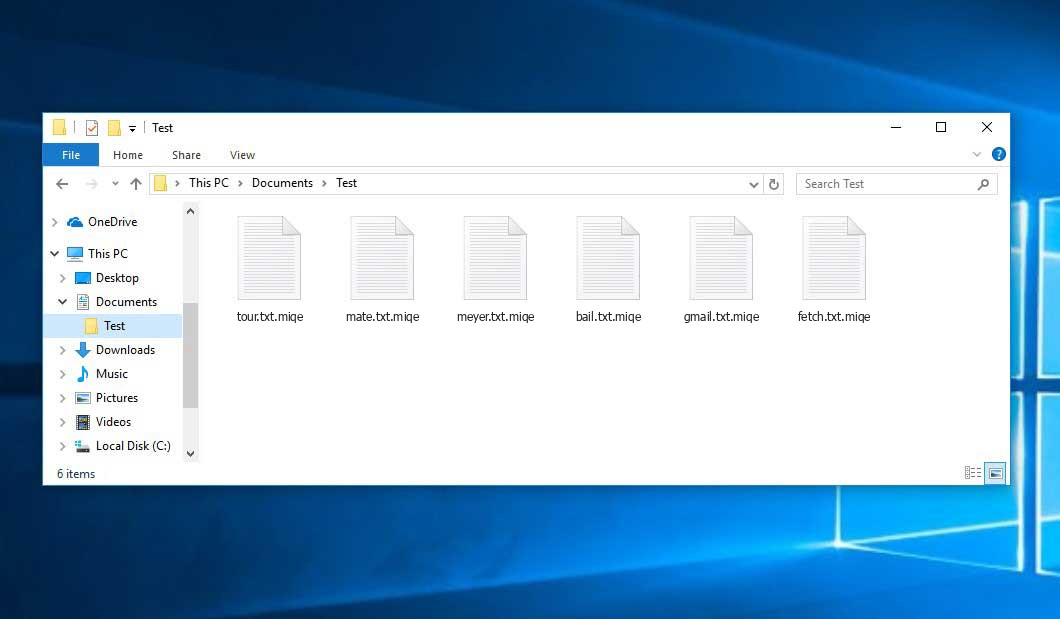While analyzing malware samples submitted to VirusTotal, I discovered the Miqe ransomware, a member of the STOP/Djvu ransomware family, encrypting files and appending the “.miqe” extension to their original filenames. For example, a file originally named “a.jpg” would be renamed as “a.jpg.miqe“, while “b.doc” would transform into “b.doc.miqe“.
The Miqe ransomware employs a unique key for each victim, with one exception:
- If Miqe fails to establish a connection with the command and control server (C&C Server) before initiating the encryption process, it resorts to the offline key. This particular key is shared among all victims, offering the possibility of decrypting files affected by a ransomware attack.
I have compiled an extensive list of potential solutions, tips, and best practices to neutralize the Miqe virus and recover encrypted files. Depending on the circumstances, file recovery may be either straightforward or impossible.
What is Miqe virus?
MIQE
🤔 Miqe virus is ransomware that originates from the DJVU/STOP family. Its primary purpose is to encrypt files that are important to you. After that ransomware virus asks its victims for a ransom fee ($490 – $980) in Bitcoin.
The Miqe virus belongs to the STOP/DJVU family of ransomware infections. Miqe ransomware encrypts various file types, including videos, photos, and documents, which become identifiable by a distinct miqe file extension. As a result, the affected files become inaccessible and unusable.
The image below gives a clear vision of how the files with “.miqe” extension look like:
| Name | Miqe Virus |
| Ransomware family1 | DJVU/STOP2 ransomware |
| Extension | .miqe |
| Ransomware note | _readme.txt |
| Ransom | From $490 to $980 (in Bitcoins) |
| Contact | support@fishmail.top, datarestorehelp@airmail.cc |
| Detection | Mal/ExeSax-A, TrojanDropper:Win32/Agent.FU, Trojan.Win32.VB |
| Symptoms |
|
| Fix Tool | To remove possible malware infections, scan your PC: 6-day free trial available. |
This _readme.txt file asking payment is for restore files via decryption key:
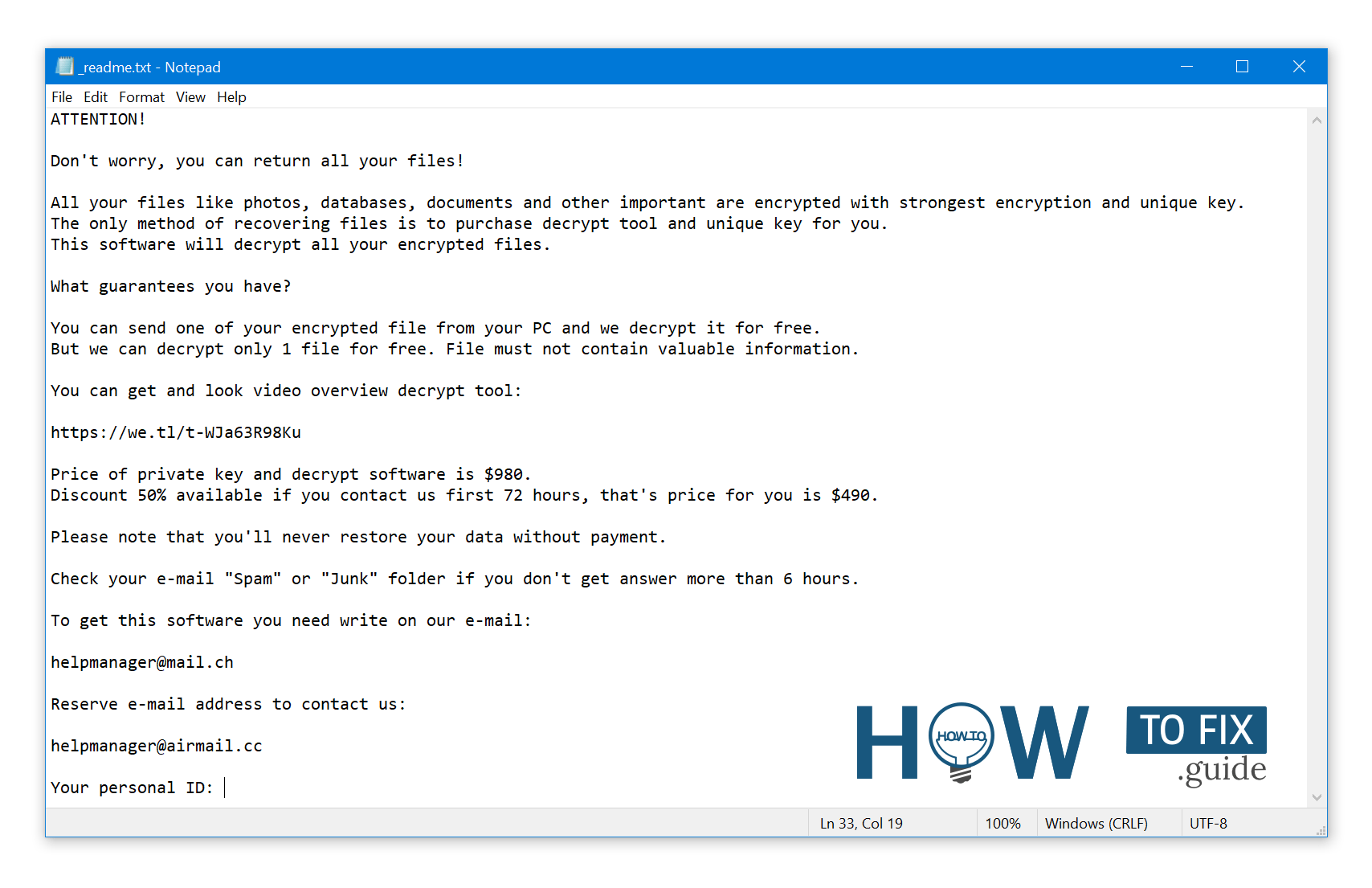
_readme.txt (STOP/DJVU Ransomware) – The scary alert demanding from users to pay the ransom to decrypt the encoded files contains these frustrating warnings
Miqe ransomware arrives as a set of processes that are meant to perform different tasks on a victim’s computer. One of the first ones being launched is winupdate.exe, a tricky process that displays a fake Windows update prompt during the attack. This is meant to convince the victim that a sudden system slowdown is caused by a Windows update. However, at the same time, the ransomware runs another process (usually named by four random characters) which starts scanning the system for target files and encrypting them. Next, the ransomware deletes Volume Shadow Copies from the system using the following CMD command:
vssadmin.exe Delete Shadows /All /Quiet
Once deleted, it becomes impossible to restore the previous computer state using System Restore Points. The thing is, ransomware operators are getting rid of any Windows OS-based methods that could help the victim to restore files for free. In addition, the crooks modify the Windows HOSTS file by adding a list of domains to it and mapping them to the localhost IP. As a result, the victim will run into a DNS_PROBE_FINISHED_NXDOMAIN error when accessing one of the blocked websites.
We noticed that ransomware attempts to block websites that publish various how-to guides for computer users. It is evident that by restricting specific domains, the crooks are trying to prevent the victim from reaching relevant and helpful ransomware-attack-related information online. The virus also saves two text files on the victim’s computer that provide attack-related details – the victim’s public encryption key and personal ID. These two files are called bowsakkdestx.txt and PersonalID.txt.
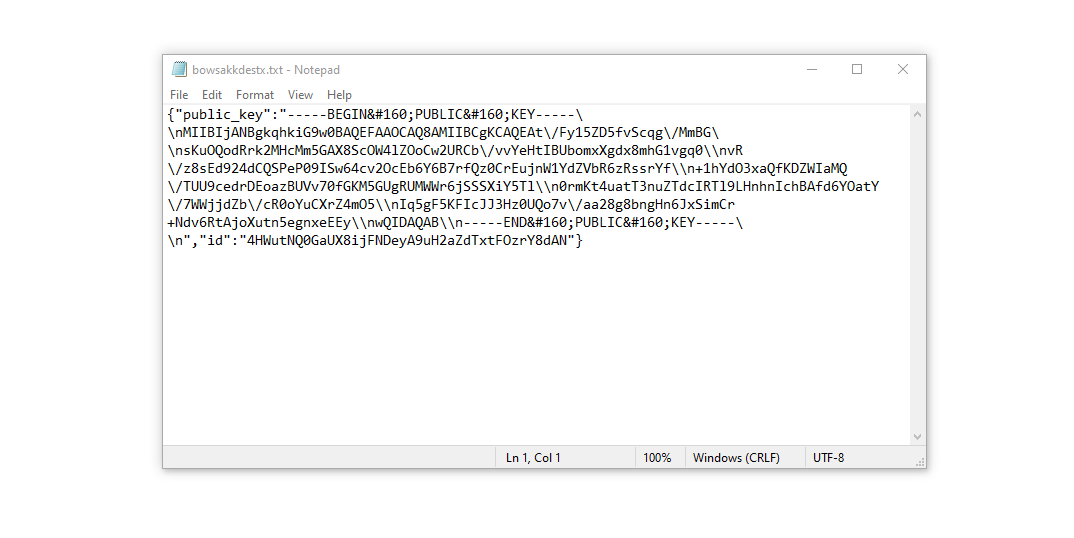
After all these modifications, the malware doesn’t stop. Variants of STOP/DJVU tend to drop Vidar password-stealing Trojan on compromised systems. This threat has a lengthy list of capabilities, such as:
- Stealing Steam, Telegram, Skype login / password;
- Stealing cryptocurrency wallets;
- Downloading malware to the computer and running it;
- Stealing browser cookies, saved passwords, browsing history, and more;
- Viewing and manipulating files on victim’s computer;
- Allowing the hackers to perform other tasks on the victim’s computer remotely.
The cryptography algorithm used by DJVU/STOP ransomware family is Salsa20. So, if your documents got encrypted with an online decryption key, which is totally unique. The sad reality is that it is impossible to decrypt the files without the unique key.
In case if Miqe worked in online mode, it is impossible for you to gain access to the Salsa20 key. It is stored on a remote server owned by the frauds who promote the Miqe infection.
For receiving decryption key the payment should be $980. To obtain the payment details, the victims are encouraged by the message to contact the frauds by email (support@fishmail.top).
The message by the ransomware states the following information:
ATTENTION! Don't worry, you can return all your files! All your files like photos, databases, documents and other important are encrypted with strongest encryption and unique key. The only method of recovering files is to purchase decrypt tool and unique key for you. This software will decrypt all your encrypted files. What guarantees you have? You can send one of your encrypted file from your PC and we decrypt it for free. But we can decrypt only 1 file for free. File must not contain valuable information. You can get and look video overview decrypt tool: https://we.tl/t-WJa63R98Ku Price of private key and decrypt software is $980. Discount 50% available if you contact us first 72 hours, that's price for you is $490. Please note that you'll never restore your data without payment. Check your e-mail "Spam" or "Junk" folder if you don't get answer more than 6 hours. To get this software you need write on our e-mail: support@fishmail.top Reserve e-mail address to contact us: datarestorehelp@airmail.cc Your personal ID: XXXXXXXXXXXXXXXXXXXXXXXXXXXXXXX
Do not pay for ransom!
Please, try to use the available backups, or Decrypter tool
The _readme.txt file clearly stipulates that computer owners should promptly contact Miqe representatives within 72 hours from the moment their files are encrypted. By doing so, users can avail themselves of a 50% rebate, effectively reducing the ransom amount to $490. However, I strongly advise against paying the ransom under any circumstances!
Rather than engaging with these fraudulent individuals, there are more effective and legitimate solutions to recover your lost data. One highly recommended approach is to utilize available backups or employ the Decrypter tool from Emsisoft.
All ransomware viruses follow a similar process to generate a unique decryption key for recovering encrypted data. Consequently, attempting manual recovery is often an infeasible option, unless the ransomware is still under development or contains hard-to-track flaws. Therefore, the best defense against data loss is to regularly back up your critical files.
Remember that maintaining backups alone is insufficient; they should be stored securely in a specific location separate from your main workstation. For instance, you can store your backup on a USB flash drive, an alternative external hard drive, or explore the option of using online (cloud) information storage.
Be mindful that keeping backup data on your primary device may expose it to the same encryption risks as other files. Hence, placing your backup on the main computer is not advisable.
By following these preventive measures and taking proactive steps, you can significantly reduce the risk of falling victim to ransomware attacks and protect your precious data from being held hostage. Regularly backing up your files to a secure location ensures that you have a failsafe to rely on should the unfortunate occur. In conclusion, stay informed, stay cautious, and stay one step ahead of ransomware threats.
How I was infected?
Ransomware has a various methods to built into your system. But it doesn’t really matter what concrete way was used in your case.

Miqe virus attack following a successful phishing attempt.
Despite the growing awareness of cybersecurity, ransomware like the Miqe virus still finds its way into our computers through various channels. Let’s explore the common leaks through which this malicious software may be injected into your PC:
1. Firstly, hidden installation often occurs alongside other apps, especially utilities that are offered as freeware or shareware. These seemingly harmless programs might carry the hidden payload.
2. Secondly, be wary of dubious links in spam emails, as they may lead you to the virus installer. Cybercriminals often use email as a means to distribute ransomware.
3. Thirdly, avoid using online free hosting resources that may unknowingly harbor malware. These platforms can become breeding grounds for dangerous software.
4. Lastly, downloading pirated software from illegal peer-to-peer (P2P) resources poses significant risks. Not only is it unlawful, but it can also expose your computer to serious malware, including the Miqe ransomware.
Some cases of the Miqe virus have been disguised as legitimate tools, such as messages urging you to initiate unwanted software or browser updates. These online frauds manipulate users into manually installing the ransomware, making them unwitting participants in the infection process.
The bogus update alert won’t directly indicate that you’re about to inject ransomware. Instead, it will cloak the installation under the pretense of updating Adobe Flash Player or some other dubious program.
It’s crucial to be cautious with cracked apps as well, as using P2P platforms for such downloads is both illegal and increases the risk of malware infection, including the Miqe ransomware.
While there is no foolproof way to guarantee your PC’s safety, I want to share some essential tips to help prevent Miqe ransomware from penetrating your system:
- Always read what additional offers the installers present alongside the main free program.
- Beware of opening attachments from suspicious emails or files from unknown senders.
- Keep your security program up-to-date to enhance your computer’s protection.
The Miqe malware does not openly reveal itself in the list of your installed programs. Instead, it masquerades as a malicious process running discreetly in the background from the moment you launch your PC.
In conclusion, by being vigilant during software installations, avoiding suspicious links and attachments, and maintaining an updated security program, you can significantly reduce the chances of falling victim to the Miqe ransomware and protect your PC from potential harm.
How To Remove Miqe Virus Ransomware?
Remove Miqe Virus with Gridinsoft Anti-Malware
We have also been using this software on our systems ever since, and it has always been successful in detecting viruses. It has blocked the most common Ransomware as shown from our tests with the software, and we assure you that it can remove Miqe Virus as well as other malware hiding on your computer.

To use Gridinsoft for remove malicious threats, follow the steps below:
1. Begin by downloading Gridinsoft Anti-Malware, accessible via the blue button below or directly from the official website gridinsoft.com.
2.Once the Gridinsoft setup file (setup-gridinsoft-fix.exe) is downloaded, execute it by clicking on the file.

3.Follow the installation setup wizard's instructions diligently.

4. Access the "Scan Tab" on the application's start screen and launch a comprehensive "Full Scan" to examine your entire computer. This inclusive scan encompasses the memory, startup items, the registry, services, drivers, and all files, ensuring that it detects malware hidden in all possible locations.

Be patient, as the scan duration depends on the number of files and your computer's hardware capabilities. Use this time to relax or attend to other tasks.
5. Upon completion, Anti-Malware will present a detailed report containing all the detected malicious items and threats on your PC.

6. Select all the identified items from the report and confidently click the "Clean Now" button. This action will safely remove the malicious files from your computer, transferring them to the secure quarantine zone of the anti-malware program to prevent any further harmful actions.

8. If prompted, restart your computer to finalize the full system scan procedure. This step is crucial to ensure thorough removal of any remaining threats. After the restart, Gridinsoft Anti-Malware will open and display a message confirming the completion of the scan.
Remember Gridinsoft offers a 6-day free trial. This means you can take advantage of the trial period at no cost to experience the full benefits of the software and prevent any future malware infections on your system. Embrace this opportunity to fortify your computer's security without any financial commitment.
Trojan Killer for “Miqe Virus” removal on locked PC
In situations where it becomes impossible to download antivirus applications directly onto the infected computer due to malware blocking access to websites, an alternative solution is to utilize the Trojan Killer application.

There is a really little number of security tools that are able to be set up on the USB drives, and antiviruses that can do so in most cases require to obtain quite an expensive license. For this instance, I can recommend you to use another solution of GridinSoft - Trojan Killer Portable. It has a 14-days cost-free trial mode that offers the entire features of the paid version. This term will definitely be 100% enough to wipe malware out.
Trojan Killer is a valuable tool in your cybersecurity arsenal, helping you to effectively remove malware from infected computers. Now, we will walk you through the process of using Trojan Killer from a USB flash drive to scan and remove malware on an infected PC. Remember, always obtain permission to scan and remove malware from a computer that you do not own.
Step 1: Download & Install Trojan Killer on a Clean Computer:
1. Go to the official GridinSoft website (gridinsoft.com) and download Trojan Killer to a computer that is not infected.

2. Insert a USB flash drive into this computer.
3. Install Trojan Killer to the "removable drive" following the on-screen instructions.

4. Once the installation is complete, launch Trojan Killer.
Step 2: Update Signature Databases:
5. After launching Trojan Killer, ensure that your computer is connected to the Internet.
6. Click "Update" icon to download the latest signature databases, which will ensure the tool can detect the most recent threats.

Step 3: Scan the Infected PC:
7. Safely eject the USB flash drive from the clean computer.
8. Boot the infected computer to the Safe Mode.
9. Insert the USB flash drive.
10. Run tk.exe
11. Once the program is open, click on "Full Scan" to begin the malware scanning process.

Step 4: Remove Found Threats:
12. After the scan is complete, Trojan Killer will display a list of detected threats.

13. Click on "Cure PC!" to remove the identified malware from the infected PC.
14. Follow any additional on-screen prompts to complete the removal process.

Step 5: Restart Your Computer:
15. Once the threats are removed, click on "Restart PC" to reboot your computer.
16. Remove the USB flash drive from the infected computer.
Congratulations on effectively removing Miqe Virus and the concealed threats from your computer! You can now have peace of mind, knowing that they won't resurface again. Thanks to Gridinsoft's capabilities and commitment to cybersecurity, your system is now protected.
How To Decrypt .miqe Files?
How to restore big .miqe files?
Try removing .miqe extension on a few BIG files and opening them. Either ransomware read and did not encrypt the file, or it bugged and did not add the filemarker. If your files are very large (2GB+), the latter is most likely. Please, let me know in comments if that will work for you.
The newest extensions released around the end of August 2019 after the criminals made changes. This includes Miza Virus, Gaqq Virus, Waqq Virus, Kiqu Virus, etc.
As a result of the changes made by the criminals, STOPDecrypter is no longer supported. It has been removed and replaced with the Emsisoft Decryptor for STOP Djvu Ransomware developed by Emsisoft.
You can download free decryption tool here: Decryptor for STOP Djvu.
Download and run decryption tool.
Start downloading the decryption tool.
Make sure to launch the decryption utility as an administrator. You need to agree with the license terms that will come up. For this purpose, click on the “Yes” button:
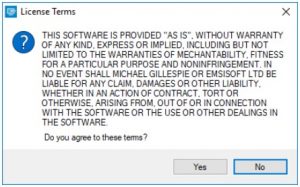
As soon as you accept the license terms, the main decryptor user interface comes up:
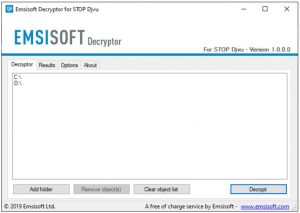
Select folders for decryption.
Based on the default settings, the decryptor will automatically populate the available locations in order to decrypt the currently available drives (the connected ones), including the network drives. Extra (optional) locations can be selected with the help of the “Add” button.
Decryptors normally suggest several options considering the specific malware family. The current possible options are presented in the Options tab and can be activated or deactivated there. You may locate a detailed list of the currently active Options below.
Click on the “Decrypt” button.
As soon as you add all the desired locations for decryption into the list, click on the “Decrypt” button in order to initiate the decryption procedure.
Note that the main screen may turn you to a status view, letting you know of the active process and the decryption statistics of your data:
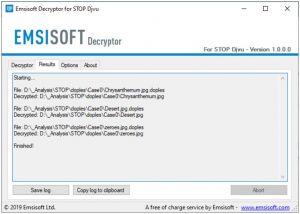
The decryptor will notify you as soon as the decryption procedure is completed. If you need the report for your personal papers, you can save it by choosing the “Save log” button. Note that it is also possible to copy it directly to your clipboard and to paste it into emails or messages here if you need to do so.
The Emsisoft Decryptor might display different messages after a failed attempt to restore your miqe files:
✓ Error: Unable to decrypt file with ID: [your ID]
✓ No key for New Variant online ID: [your ID]
Notice: this ID appears to be an online ID, decryption is impossible
✓ Result: No key for new variant offline ID: [example ID]
This ID appears be an offline ID. Decryption may be possible in the future.
It can take a few weeks or months until the decryption key gets found and uploaded to the decryptor. Please follow updates regarding the decryptable DJVU versions here.
✓ Remote name could not be resolved
How to Restore .miqe Files?
In some case Miqe ransomware is not doom for your files…
Miqe ransomware encryption mechanism feature is next: it encrypts every file byte-by-byte, then saves a file copy, deleting (and not overriding!) the original file. Hence, the information of the file location on the physical disk is lost, but the original file is not deleted from the physical disk. The cell, or the sector where this file was stored, can still contain this file, but it is not listed by the file system and can be overwritten by data that has been loaded to this disk after the deletion. Hence, it is possible to recover your files using special software.
Anyway, after realizing it was an online algorithm, it is impossible to retrieve my encrypted files. I also had my backup drive plugged in at the time of the virus, and this was also infected, or so I thought. Every folder within my backup drive had been infected and was encrypted. However, despite losing some important files, I retrieved almost 80% of my 2TB storage.
When I started going through the folders, I noticed the readme.txt ransom note in every folder. I opened some of the folders and found that all files that were not in a subfolder within that folder had been encrypted. However, I found a flaw and glimmer of hope when I went into the subfolders in other folders and found that these files had not been encrypted. Every folder within my c and d drives, including subfolders, had been encrypted, but this was not the case with the backup drive. Having subfolders created within a folder has saved 80% of my data.
As I said, I believe this to be only a small loophole on a backup drive. I’ve since found a further 10 % of my data on another hard drive on a different pc. So my advice is if you use a backup drive, create subfolders. I was lucky, I guess. But I was also unlucky that the virus hit as I was transferring some files from my backup.
Hopefully, this can help some other people in my situation.
Jamie NewlandRecovering your files with PhotoRec
PhotoRec is an open-source program, which is originally created for files recovery from damaged disks, or for files recovery in case if they are deleted. However, as time has gone by, this program got the ability to recover the files of 400 different extensions. Hence, it can be used for data recovery after the ransomware attack
At first, you need to download this app. It is 100% free, but the developer states that there is no guarantee that your files will be recovered. PhotoRec is distributed in a pack with other utility of the same developer – TestDisk. The downloaded archive will have TestDisk name, but don’t worry. PhotoRec files are right inside.
To open PhotoRec, you need to find and open “qphotorec_win.exe” file. No installation is required – this program has all the files it need inside of the archive, hence, you can fit it on your USB drive, and try to help your friend/parents/anyone who was been attacked by DJVU/STOP ransomware.
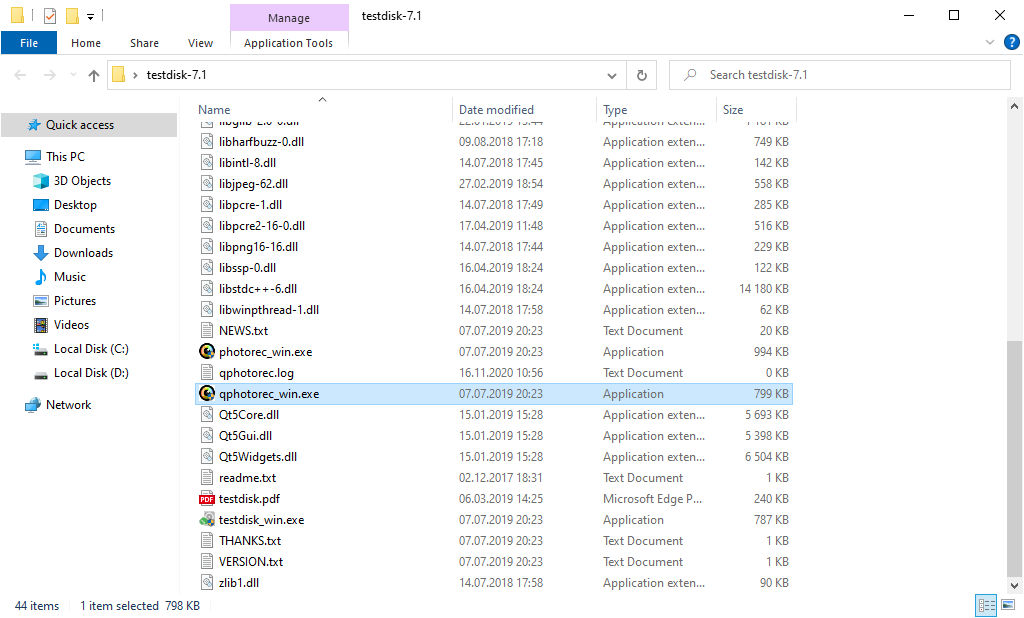
After the launch, you will see the screen showing you the full list of your disk spaces. However, this information is likely useless, because the required menu is placed a bit higher. Click this bar, then choose the disk which was attacked by ransomware.
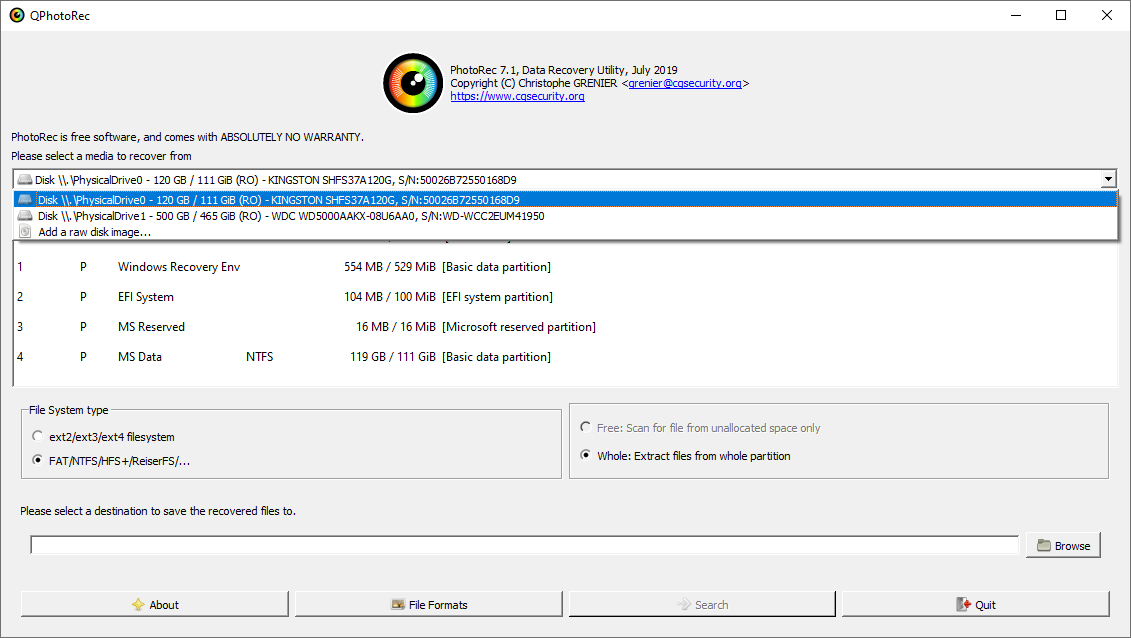
After choosing the disk, you need to choose the destination folder for the recovered files. This menu is located at the lower part of the PhotoRec window. The best desicion is to export them on USB drive or any other type of removable disk.
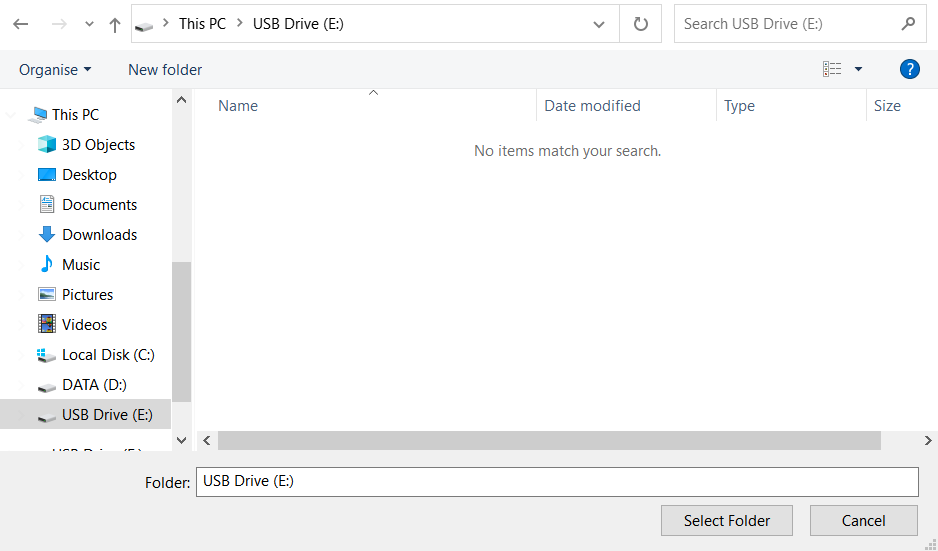
Then, you need to specify the file formats. This option is located at the bottom, too. As it was mentioned, PhotoRec can recover the files of about 400 different formats.
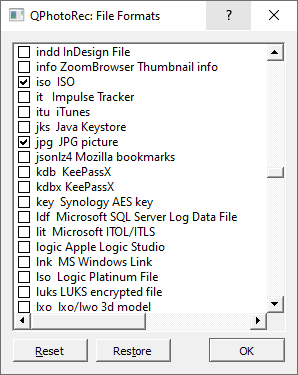
Finally, you can start files recovery by pressing the “Search” button. You will see the screen where the results of the scan and recovery are shown.
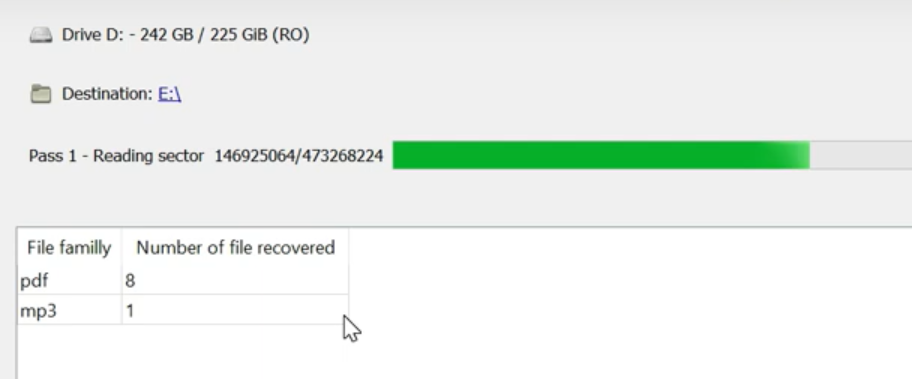
Miqe files recovery guide
Frequently Asked Questions
No way. These files are encrypted by ransomware. The contents of encrypted files are not available until they are decrypted.
If your data remained in the .miqe files are very valuable, then most likely you made a backup copy.
If not, then you can try to restore them through the system function – Restore Point.
All other methods will require patience.
Of course not. Your encrypted files do not pose a threat to the computer. What happened has already happened.
You need GridinSoft Anti-Malware to remove active system infections. The virus that encrypted your files is most likely still active and periodically runs a test for the ability to encrypt even more files. Also, these viruses install keyloggers and backdoors for further malicious actions (for example, theft of passwords, credit cards) often.
In this situation, you need to prepare the memory stick with a pre-installed Trojan Killer.
Have patience. You are infected with the new version of STOP/DJVU ransomware, and decryption keys have not yet been released. Follow the news on our website.
We will keep you posted on when new keys or new decryption programs appear.
The Miqe ransomware encrypts only the first 150KB of files. So MP3 files are rather large, some media players (Winamp for example) may be able to play the files, but – the first 3-5 seconds (the encrypted portion) will be missing.
You can try to find a copy of an original file that was encrypted:
- Files you downloaded from the Internet that were encrypted and you can download again to get the original.
- Pictures that you shared with family and friends that they can just send back to you.
- Photos that you uploaded on social media or cloud services like Carbonite, OneDrive, iDrive, Google Drive, etc)
- Attachments in emails you sent or received and saved.
- Files on an older computer, flash drive, external drive, camera memory card, or iPhone where you transferred data to the infected computer.
If the guide doesn’t help you to remove Miqe infection, please download the GridinSoft Anti-Malware that I recommended. Do not forget to share your experience in solving the problem. Please leave a comment here! This can help other victims to understand they are not alone. And together we will find ways to deal with this issue.
I need your help to share this article.
It is your turn to help other people. I have written this article to help users like you. You can use buttons below to share this on your favorite social media Facebook, Twitter, or Reddit.
Brendan SmithMIQE Ransomware — How To Restore & Decrypt Files?
Name: MIQE Virus
Description: The MIQE Virus belongs to the STOP/DJVU family of ransomware infections. This malicious software encrypts various file types, including videos, photos, and documents, which become identifiable by a distinct miqe extension. As a result, the affected files become inaccessible and unusable.
Operating System: Windows
Application Category: Virus
User Review
( votes)References
![]() German
German ![]() Japanese
Japanese ![]() Spanish
Spanish ![]() Portuguese (Brazil)
Portuguese (Brazil) ![]() French
French ![]() Turkish
Turkish ![]() Chinese (Traditional)
Chinese (Traditional) ![]() Korean
Korean ![]() Indonesian
Indonesian



